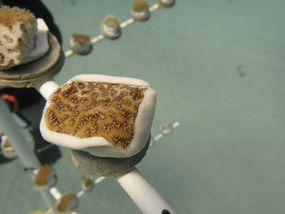
Coral Nurseries
Our in-situ
Coral Nurseries
Coral nurseries are at the core of coral reef restoration. These spaces serve to harness the power of asexual reproduction by increasing growth and survivorship in a controlled setting. Our in-situ nurseries provide a balance between isolation (from predation, competition, disease, etc.) and exposure to real-world conditions (water quality, temperature, nutrients, etc.). We have tested multiple nursery designs and sites over the years, allowing us to increase nursery installation, maintenance, and monitoring efficiency at tested sites.

Sea Ventures MRU diver during the maintenance of coral fragments in a nursery tree.

Sponges are keystone species of coral reefs, meaning that without them the whole ecosystem can collapse. By filtering water and recycling nutrients, sponges have tremendous potential in the coral restoration process.
Adaptability is key in our nurseries so we recognize the importance of in-situ conditions for the future outplanting in the reef. Through innovative techniques such as fragment propagation and outplanting, we foster the growth and regeneration of many species of corals and sponges such as Acroporids, Dendrogyra cylindrus, and Xestospongia muta. This not only aids in the recovery of dwindling populations but also contributes to the overall health and stability of coral reef ecosystems. These nurseries are hope amidst the perilous decline of this species in the Caribbean. Recently we have been working on the expansion of D.cylindrus nurseries and rescuing fragments of different genotypes isolated in underwater trees to protect them from disease.
Fragments in the nurseries
Photos of coral fragments from highly susceptible species (Dendrogyra cylindrus and Meandrina meandrites) isolated in underwater nurseries.

Benthic Underwater Coral Arrays (BUCAs) installed and maintained by Sea Ventures in La Parguera Natural Reserve, southwest Puerto Rico.











